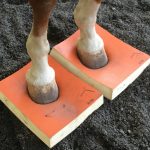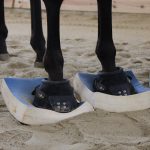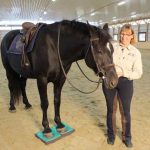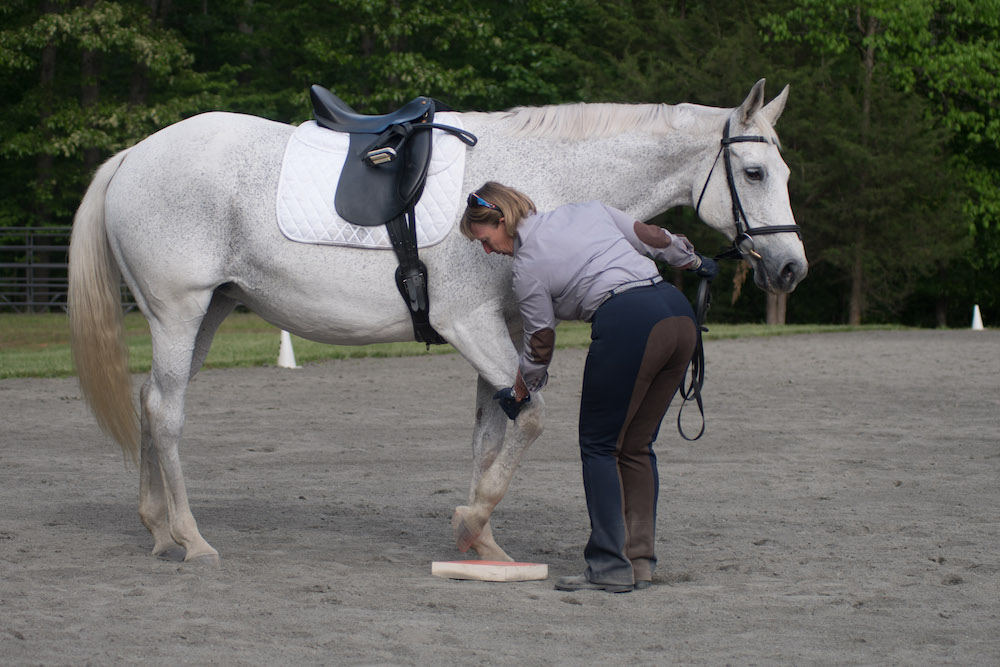Diesel had a habit of shying. He would shy at poles on the ground and objects that he had been exposed to many times before. When we introduced him to the SURE FOOT pads he was very mistrustful. He didn’t want anything to do with them at first, habitually shying away from them on the ground as well. That is until he spent several days experiencing the SURE FOOT Equine Stability Program. It took several sessions gradually working with him to overcome his fear, find comfort, and finally overcome his habitual pattern. When he did he was able to walk between tires and logs without changing speed or holding his breath without any prior groundwork!
 Diesel’s pattern is typical of a horse that will shy or pull back. When concerned he would push against the ground with his front feet in a sideways motion. This pattern I now consider typical of horse’s that shy and by using SURE FOOT, not only could we clearly see the pattern, as if in slow motion, we watched as the horse become self-aware and finally discover new ways of standing, moving and placing his hooves on the ground all by himself.
Diesel’s pattern is typical of a horse that will shy or pull back. When concerned he would push against the ground with his front feet in a sideways motion. This pattern I now consider typical of horse’s that shy and by using SURE FOOT, not only could we clearly see the pattern, as if in slow motion, we watched as the horse become self-aware and finally discover new ways of standing, moving and placing his hooves on the ground all by himself.
As his habitual pattern lessened Diesel became more relaxed, lowering his head and softening while standing on the pads. We could then use the pads to “trigger” this relaxation so that he could respond to objects in his environment rather than react. In that way, we could “switch” Diesel from fight and flight to grazing without increasing his stress levels. It was clear he was already stressed by the situation therefore he didn’t need more arousal. What Diesel needed was a way to switch off the fight and flight and turn on the relaxation response.
Diesel went form suspicious and self-preserving to curious and finally to relax while on the pads. As these changes happened his riders could feel the change in his body from the saddle. While it is not necessary to be mounted during a SURE FOOT session, it does give the rider an opportunity to feel the habitual patterns of tension melt away.
Sometimes faster sometimes slower, horses begin to learn to “throw the switch” from fight and flight to on their own! They go from parasympathetic (grazing) to an even deeper level of relaxation that is related to brain chemicals, endorphins. The lips begin to droop, eyes blink, and close and the horse is no longer interested in his environment. Some begin to sway gently while others rock quickly for a moment. Each horse is unique in the way he responds to the pads just as each person is unique in her habitual patterns of standing and moving. But, within a short period of time, the horse typically lets go of his old patterns in favor of a more relaxed movement, and with that change you can see them gain balance and confidence.
What is the SURE FOOT Equine Stability Program?
 Quite simply it is an opportunity for your horse to become aware of his habits and change his own behavior and movement. This may seem quite astonishing at first when you consider that your horse can reprogram his own brain. But that is exactly what happens. You offer your horse an opportunity to experience the way he stands habitually by placing an unstable surface under his hooves. Beginning with one foot at a time the horse chooses whether or not to remain on the pads. The experience is an offer, not a requirement. It is imperative that the horse can choose to stand on the pads or not and for how long (although I will at times ask the horse to walk off). This is quite different from training, which is when we impose our ideas on the horse. Even if the training is “good for him” it is still something we decide we want the horse to do rather than something the horse wants to do.
Quite simply it is an opportunity for your horse to become aware of his habits and change his own behavior and movement. This may seem quite astonishing at first when you consider that your horse can reprogram his own brain. But that is exactly what happens. You offer your horse an opportunity to experience the way he stands habitually by placing an unstable surface under his hooves. Beginning with one foot at a time the horse chooses whether or not to remain on the pads. The experience is an offer, not a requirement. It is imperative that the horse can choose to stand on the pads or not and for how long (although I will at times ask the horse to walk off). This is quite different from training, which is when we impose our ideas on the horse. Even if the training is “good for him” it is still something we decide we want the horse to do rather than something the horse wants to do.
An experiment with a surprising outcome
The spark for SURE FOOT came two and one-half years ago. I got the idea to place an air-filled balance disc under a horse’s hoof, thanks to Dr. Joyce Harman and a horse named Dante. I wanted to help him sense his own body. For one month he was ridden in a saddle that caused a problem with his right hind leg. We changed the saddle but the uneven movement was still visible at the end of the Monday lesson. I was going to see him again the next day. During our conversation, Joyce talked about how dogs were placed on a variety of unstable surfaces for rehabilitation. I wondered how that would work with Dante. She thought it might help and suggested he only stand on the balance disc for 15 seconds. In 15 seconds my life changed in the most unexpected way!
I had no preconceived notion of what might happen when, with the owner mounted, I placed the balance disc under Dante’s hoof. I was simply interested in seeing what might happen. As a Feldenkrais Practitioner® I knew that there were Feldenkrais® lessons where we stood on an unstable surface like a foam roller. I have used balance and wobble boards to help riders improve their balance and knew balance discs were used in physical therapy and sports training. But I didn’t know how a horse would respond.
In 15 seconds Dante walked off the pad moving in a completely different way. His right hind leg was swinging more freely whereas only a moment before it was stepping short. I continued to place the two discs under his back feet for very short periods of time and watched as he continued to move better and better. Over the course of the hour I could put two pads under Dante’s back feet but he would not let me put them under his front feet. In fact, he was quite frightened by the idea. I did not force the issue and he went home a changed horse.
The next horse was a quarter horse that had been trained in Western Pleasure. The rider wanted to use him for eventing. He had the shuffle canter, which she hoped I could improve. I placed the discs under his front feet easily but he was very concerned when I put them under his back feet. None-the-less, after standing on the discs for brief periods of time, he was completely different in the way he cantered in less than one hour. I was hooked!
Andy, the third horse that day, was a Halflinger. He was used for therapeutic driving and his owner, Catherine Wycoff PT Ph.D., Hippotherapist and Feldenkrais Practitioner®, rode him to keep him fit. This horse was totally cool about standing on the pads under both front and back feet. Again the canter went from a very heavy, on the forehand to one that was round and light in less than 1 hour. Catherine and I had a long discussion afterward about what might be happening to the horses. We weren’t entirely sure (even now no one can fully explain what is going on) but we definitely intrigued!
Since that day in May 2012, I have placed hundreds of horses on a variety of stability pads and observed what happens. The results have been astonishing. Horses that are stiff move more freely. Horses that are afraid become confident. Horses that are nervous and tense, relax. Horses that are used for dressage, jumping, driving, pleasure, trail, endurance and fox hunting have all benefited from SURE FOOT including soft-gaited horses. It seems that any horse can reorganize when presented with an experience that makes them self-aware of their habitual patterns of weighting and placing their hooves on the ground.
The horse determines the process and outcome
Each horse is unique in how he responds to SURE FOOT. In some cases, the changes occur in minutes and are permanent from only one session. Other horses need to revisit the pads over the course of a couple of weeks or months. Some horses can only do a short 10 – 15-minute session while others will stand with all four feet on pads in their first session for over 30 minutes. Some are afraid at first and pull back violently or are surprised when they feel the surface gives the first time they step off. Others act like they have been standing on the pads most of their lives and appear to fall asleep. It is hard to say how any individual horse will respond or react to standing on an unstable surface. But in almost all cases you can see an immediate change in breathing when they do.
Some horses will not stand on the stability pads at all. In those cases it is important not to force them and to consider other factors that may be underlying the reason for your horse’s concern. The few horses that I have seen that will not stand on the cushions have been diagnosed with neurologic problems. This makes sense a neurologic horse is already unstable and therefore cannot cope with being made even more unstable. What happens during a SURE FOOT session? In general the horses calm down, relax and explore the feeling of standing on an unstable surface. Observable changes include: head lowering, eye blinks, eyes closing, softening of the muzzle, ears relaxing and in general a switch from the sympathetic (flight and flight) nervous system to the parasympathetic (grazing) response. Some horses go into a deeper level of relaxation that is similar in appearance to horses that are sleeping or drugged.
Often horses begin to sway. Infrequently they will begin to sway when only standing on one pad. Swaying typically occurs when the horse is standing on two or more pads. Most horses have a repeated sway pattern but some will show a second or third pattern and then return to the original one. When all four feet are on pads horses may sway strongly at first and then less or start out little and increase as time goes by. A few horses have swayed themselves right off the pads but typically remain on. The riders often report that if feels like being on a boat at sea and when the horses walk off they can feel like “drunken spiders” until they reorganize and establish a new organization.
A few horses do something I call a quick rock. It appears as if the ribcage quickly rotates left and right between the front legs. This is a very rapid movement. Typically a horse will do this once or twice nut not repeatedly. This is often combined within a sway pattern. This may have something to do with a letting go of muscles at the top of the shoulder blades without the thoracic sling muscles stabilizing the ribcage between the front legs.
Why do horses change?
This is the question that at this point no one can answer. However, how your horse’s hooves meet the ground has everything to do with how he perceives his world. When you consider that the entire horse is standing on a total surface area about the size of your two feet it is a wonder that he can move so swiftly over all kinds of terrain while carrying the weight of a rider on his back. If these four hooves do not meet  the ground securely the horse will be uncertain. If they are not standing squarely under the load the horse will not move in an efficient way.
the ground securely the horse will be uncertain. If they are not standing squarely under the load the horse will not move in an efficient way.
SURE FOOT allows the horse to sense a new way to stand on his feet because the surface gives. This alters the way your horse stands, moves and behaves. I think almost all behavior problems are balance problems and when the horse feels a different balance on his feet he becomes more secure and sure-footed. Having put hundreds of horses on stability pads I know it works and fast! And, more importantly, the horse is his own teacher. His self-exploration is what makes SURE FOOT work. The horse is in complete control of the process and the outcome.
Allowing your horse to sense, feel, and play with standing on a surface that gives under his hoof, or reject the idea completely puts him in control of the process. In this way he becomes his own teacher. He gets to decide which foot he wants on a pad, how long he wants to stand, how he wants to explore and what happens when he steps off. You can use SURE FOOT with your horse while mounted (you will need an assistant) or unmounted, in an arena, barn aisle or anywhere he may become anxious.
You can use it to solve or improve a variety of behaviors like Mugsy’s issues with being tacked up. Others have used SURE FOOT to help horse’s that couldn’t back up, have difficulty standing for the farrier, shivers, shy, high headed or short gaited. I know of two horses that stopped twisting their hocks. I hope you will give SURE FOOT a try and please let me know what happens!
I am looking for case studies for the SURE FOOT book so please email me with your stories, wendy@wendymurdoch.com. For more information and a video of a horse on 4 pads go to www.murdochmethod.com and click on SURE FOOT.
Thanks to Joyful Noise Farm, Pryor, OK for permission to print Diesel’s story.
This article was originally printed in the Jan./Feb. issue of FOSH Magazine.




